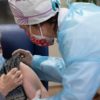Tesla has started using cabin cameras in some Model 3 and Model Y vehicles to make sure drivers are paying attention to the road when they use driver assistance features, according to release notes obtained by CNBC.
Their Model 3 and Model Y cars already had driver-facing cabin cameras, but the company’s owners manuals said they were not used for driver monitoring. Instead, Tesla’s systems required drivers to “check in” by touching the steering wheel, which is equipped with sensors.
Now, Tesla is telling drivers their cabin cameras have been switched on for driver monitoring in new vehicles that lack radar sensors, according to Kevin Smith, a second-time Tesla buyer in Murfreesboro, Tennessee. Smith says he took delivery of a 2021 Tesla Model Y crossover on Thursday.
The technical changes come amid regulatory scrutiny of Tesla vehicle safety in the U.S. and abroad. The company is facing dozens of federal probes into the underlying causes of Tesla-involved crashes in the U.S., some of which may have involved Autopilot.
Elon Musk’s auto business sells its driver assistance systems under the brand names Autopilot and Full-Self Driving, or FSD, an optional $10,000 upgrade. Tesla also offers some drivers who paid for FSD the option to try unfinished driver assistance features in its FSD Beta program, effectively turning them into beta testers.
Tesla’s owners manuals caution drivers that use of these systems requires “active supervision.” However, owners have repeatedly demonstrated over-confidence in the systems, sharing videos and accounts of driving while asleep at the wheel, driving without their hands on the wheel, or even driving while sitting in the passenger or back seat of the car.
A federal vehicle safety watchdog, the National Transportation Safety Board, has called on Tesla to stop beta-testing on public roads using customers in lieu of professionals, and to add robust driver monitoring to its vehicles.
It’s not clear whether Tesla’s new camera-based driver monitoring system and cars without radar meet the standards set forth by the NTSB or other safety standards.
One owner’s experience
Kevin Smith ordered his 2021 Model Y at the end of March and expected to get a vehicle with the sensor suite Tesla previously marketed, including radar.
But on Tuesday this week, Tesla announced it would exclude radar and downgrade the vehicles’ functionality in a blog post. The post also said Tesla will restore the missing features once Tesla transitions customers to a “pure vision” or camera-based version of its driver assistance and safety features.
Before he could get his new Model Y delivered, Smith was asked in an “Order Update” on the Tesla website to confirm that he would accept the modified car for the same price as the one he originally ordered.
The waiver noted that the company is transitioning to Tesla Vision, its camera-based Autopilot system, and that some new cars delivered beginning in May 2021 will not have radar. It also cautioned that Vision may be delivered with some features “temporarily limited or inactive” and said Tesla will restore those features with over-the-air software updates in the “weeks ahead.”
When he took delivery of his all-wheel-drive 2021 Model Y, Smith saw a “release note” in the vehicle’s touchscreen display that informed him of a cabin camera update:
“The cabin camera above your rearview mirror can now detect and alert driver inattentiveness while Autopilot is engaged. Camera data does not leave the car itself, which means the system cannot save or transmit information unless data sharing is enabled. To change your data settings, tap Controls > Safety & Security > Data Sharing on your car’s touchscreen.”
Adding a camera-based driver monitoring system does not restore the driver assistance and safety features Tesla said it had turned off for now.
Consumer Reports and the Insurance Institute for Highway Safety on Wednesday removed top-level safety endorsements for the Model 3 in the U.S. after the company announced it had excluded radar from these vehicles. Consumer Reports noted, “The government’s top vehicle safety rating agency says the vehicles may lack some key advanced safety features, including forward collision warning (FCW) and automatic emergency braking (AEB).”



